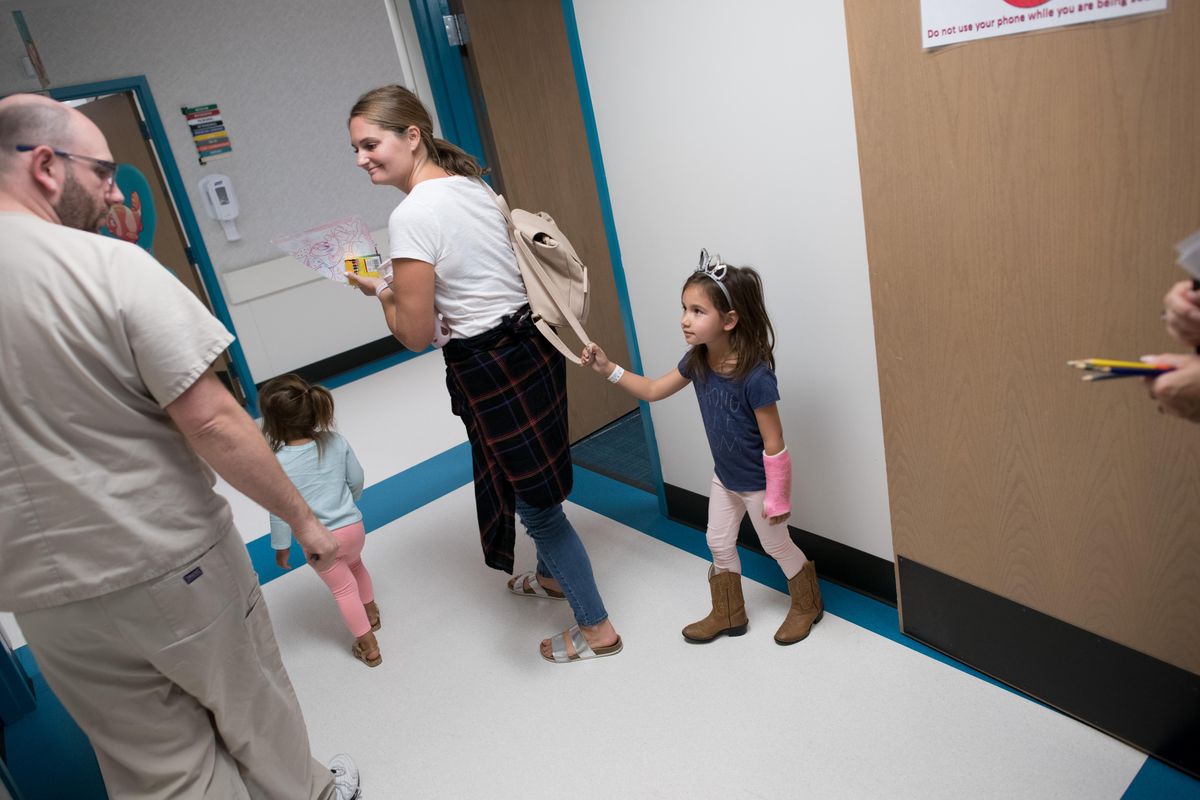Mending little bones at Shriners: Pediatric fracture clinic sees increasing number of patients

Mabel Martin kept eyes on her mom’s face.
The 4-year-old’s Aug. 21 visit at Shriners Hospital for Children in Spokane came less than three weeks after she fell from a scooter on a bumpy sidewalk and broke her left arm.
“I’m a little bit scared,” admitted Mabel, settling onto a bed in a hospital “cast room.” It’s decorated with murals of sea creatures, spaceships and other colorful images.
Seconds later, Mabel was smiling. Cast technician Scott Martin – no relation – told her she’d feel a bit of a vibration from a tool to cut a thin line on top of her cast.
“Does it tickle?” her mom, Kelsey Martin, asked at the start. “Only a little,” she said. Martin pried the glittery pink cast gently off her arm as Mable relaxed against a pillow. She studied her bare limb with an amazed look. When the discarded cast was offered as a souvenir, Mabel nodded.
“She actually loves having a permanent accessory,” her mom joked before the appointment.
Mabel had gone to a Providence urgent care facility when she was first injured. The family then was referred to the Spokane Shriners Urgent Pediatric Fracture Clinic.
“When we walked in here on a Monday, there were a bunch of Mabels here all in slings,” Kelsey Martin said. “A volunteer was dressed like a clown. Her job was to walk around and play with the kids. There were all these kids in temporary casts, and the clown. It put us at ease.”
Since its launch in 2013, the clinic has seen a 20 to 30 percent increase in the number of children treated for fractures each year. As of December, the clinic saw more than 5,000 children over a nearly five-year period.
The clinic treats patients up to age 18 for walk-in morning visits if they have a documented fracture. Insurance is accepted, but children are treated regardless of a family’s ability to pay.
Spokane’s outpatient pediatric fracture care was the first of its kind in Shriners’ philanthropic system of 22 hospitals in the U.S., Canada and Mexico. (It has since been emulated at other Shriners hospitals, being most successful in midsized cities.)
Since the 1920s, Shriners has – and still does – treat children with serious orthopedic and chronic conditions such as scoliosis, club foot, and cerebral palsy, said Dr. Bryan Tompkins, a Spokane pediatric orthopedic surgeon at Shriners for 11 years.
“The Shriners hospitals had wanted to make access easier, but we still weren’t really known for fractures or acute injury treatment,” Tompkins said.
“The basic idea is to provide a walk-in clinic every morning Monday through Friday.”
Afternoon appointments are designed for follow-up care.
“When I got here, there were no fellowship-trained pediatric orthopedists, and there still isn’t, so adult orthopedists were taking care of all the pediatric fractures and doing a good job – except there were tons of them.”
Timing also is crucial because a child’s broken bone starts to heal almost immediately, he said. A pediatric fracture in an arm might heal in two to three weeks, while a similar injury in an adult can take two or three months to mend.
“So we thought, why don’t we make a walk-in fracture clinic, which was novel to Shriners hospitals, and treat fractures right when they happened?” Tompkins said. “It wasn’t that the community wasn’t serving them, but we thought we could get to these kids quicker.”
Specialists who treat pediatric fractures also have to keep in mind a child’s growth plates, another difference from adult fracture care, he said.
“Kids have growth plates at the end of their bones, and that’s also an area where kids get fractures,” he said. “If there’s a premature closing of that growth plate, that can result in premature or future problems. And also, kids get different patterns of fractures than adults get.”
Community use of the clinic has exceeded expectations, he said.
“We didn’t expect to see the volume that we’ve seen. At first, we’d have two or three fractures a day. Now, if we don’t have 10 fractures a day, it’s slow day. Eventually, we’ll plateau, but we haven’t gotten there yet.”
As another surprise, the clinic’s busiest months for fracture care are in the fall and spring.
“When we sat down and thought about this, we thought June, July and August will be our busier months,” he said. “We were so wrong. The busiest months are always in the spring and fall.”
Each September brings the highest volume of patients, probably related to back-to-school activities and sports, he said, while August is traditionally one of the slowest months of the year.
“I think heat plays into it; the hotter the day, the less fractures, to a general degree. Snow we get busy. Smoke, nothing.”
At the Spokane clinic, there’s a focus on making children feel comfortable, Tompkins said.
“I think parents recognize that the place is geared around kids,” he said. “If they are relaxed with distractions geared to kids that are age-appropriate, there’s better outcomes for the kids.”
The fracture clinic won’t be impacted by a recent announcement that the Spokane facility will reduce its staff by about 10 percent as it makes changes with more focus on outpatient care, said spokeswoman Kristin Monasmith.
Clinic care for children’s fractures is primarily done by physicians assistants, but the hospital has a pediatric orthopedic surgeon available if any injury requires surgery. Staff also can consult with a physician who is board-certified in pediatric sports medicine.
Tompkins said the ages of kids in Spokane seen the most often because of broken bones tend to be around the toddler years, or just past elementary school.
“Middle school kids generate a ton of fractures.”